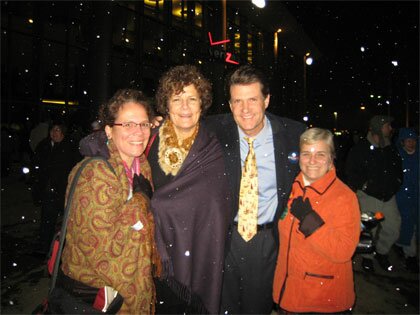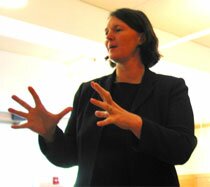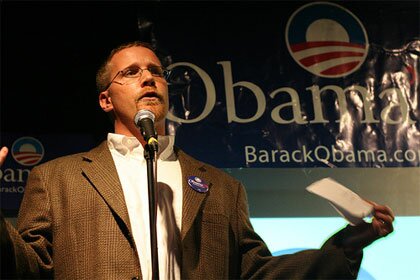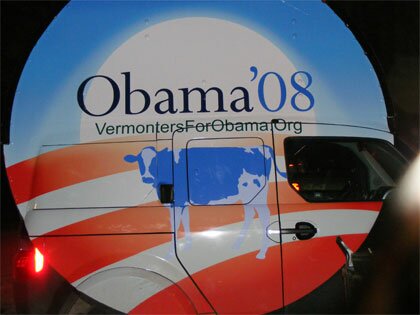March 4 Post-Mortem: Vermont Brings It
Last night? Please. VDB’s taken far worse hits in a game of Candyland. (Like when you’re just about to win, and you draw the Plumpy card, and you have to go almost all the way back to square one. That totally smarts.) For an explanation of our unruffled exterior, see yesterday’s post below, which would do just fine as today’s post, actually.

All photos by Bill Stetson (unless otherwise tagged)
But to ram it into a very small nutshell: Hillary won no delegates to speak of last night. The most optimistic projections have her netting 9 or 10; more realistic scenarios put the number at 4 or 5; and in some plausible circumstances, she might wind up a delegate poorer, when all is said and done.
And so Hillary can claim momentum this morning, and VDB would too, in her shoes; she can run all the negative ads she likes, in Wyoming and beyond; she can even, this morning, cheerfully offer herself the second spot on an Obama ticket, or suggest that he will carry her water in the general election.
But nothing will change the core reality: she cannot make up the deficit in delegates.
Last night demonstrated that very clearly, as all the hullabaloo in two of three remaining “big states” dissolved into a mathematical wash. And Democratic Party superdelegates are not about to take the nomination from the candidate with more earned delegates, when all is said and done.
By this time next week, we will be back where we were at this time last week: Obama with an insurmountable lead, coming off multiple wins, and fencing openly with John McCain.
So let’s spend the remaining lines here to concentrate on something more rewarding, which is to say, the results here in Vermont.
Always gratifying to see the national media hit the same three default keys again and again: calling Ben & Jerry’s on Church Street to sample public opinion, chuckling over the “Dead or Alive” resolution passed in Brattleboro, and dismissing the entire ballot result — the night’s widest and clearest margin — as predictable and therefore not newsworthy.
Not that the local newscasts did all that much better. We lost track of the number of times various pundits claimed that neither Hillary nor Obama visited the state. Which is dead wrong, but instructively wrong, at least.
Sure, neither campaigned here in the actual run-up to the vote. But Obama made two Vermont visits in the last two years, the second building very methodically on the first. He campaigned initially for Peter Welch and Bernie Sanders, helping both to eventually claim their seats; when he returned for a fundraiser last summer, at the Norwich home of Democratic stalwarts Bill and Jane Stetson, he had the entire Congressional delegation in attendance, and raised the largest total in Vermont history.

The Stetsons, center, with friends
Many of the hundreds who canvassed for Obama on March 1 were among the thousands who heard him speak at the Ira Allen Chapel in 2006. Obama did not ignore the state. Far from it.
In its focus on the relatively abstract (the Economy, the War, Change) even the local media lost sight of the relatively concrete: Obama’s campaign in Vermont was on the ground very early, succeeded in all the traditional ways, and broke new ground — even for the home of the Dean campaign — in cyber-organizing.
So yes, Obama’s early opposition to the War struck a deep chord here, as did his turn-the-page message, but as much as anything yesterday’s 20-point margin can be traced directly to hands-on, grass-roots, hard-core campaigning, conducted far earlier than anyone expected.
 It is no accident that Obama outraised all other Presidential candidates combined in Vermont: Carolyn Dwyer gave it her full attention. (Which is to say, of course, that Dwyer’s full attention is greater than the sum of all the attention spans of all the rest of the fundraisers for all the rest of the candidates combined.) There is no one better at what she does, and the fact that she signed on with Obama early was a major turning point.
It is no accident that Obama outraised all other Presidential candidates combined in Vermont: Carolyn Dwyer gave it her full attention. (Which is to say, of course, that Dwyer’s full attention is greater than the sum of all the attention spans of all the rest of the fundraisers for all the rest of the candidates combined.) There is no one better at what she does, and the fact that she signed on with Obama early was a major turning point.
And the much-vaunted networking software developed by Chris Hughes for the Obama campaign is nothing without highly skilled statewide administrators to channel and shape the eventual wave of energetic newbies.
Which is precisely where Neil Jensen came in.
Neil started Vermonters for Obama, way back in late 2006, before the junior Senator from Illinois was a candidate, before the Obama bandwagon had a band. Before it even had a freaking wagon.

Photo by Jim Brayton
And at every meeting of the group, meetings that grew larger and larger, Neil pitched the software itself, explained it, nudged people into registering and experimenting with it. And it worked.
By February of 2008, the organizational infrastructure was pulsing, growing exponentially, and the Vermonters for Obama URL was emblazoned on Barackmobiles criss-crossing the state.

Photo by Elizabeth Wilhjelm
Our point? Twenty-point margins don’t just happen, even with once in a generation candidates: they’re made, by individuals with the courage of their convictions. The courage to come out early, publicly, and stand by a candidate who shares their beliefs.

And that point shouldn’t get lost, ever, in the more general discussion of Hope and War and Change.
[Many thanks to Bill Stetson, Elisabeth Wilhjelm, and Jim Brayton for the excellent photos accompanying this post.]
on May 23rd, 2008 at 5:02 pm
[…] On the morning after Vermont’s primary, a big night for Obama as predicted, I wrote a long diary trying to make clear why I thought the Senator had done so well in the Green Mountain State. Half of that diary revolved around the abilities and highly productive obsessions of a friend of mine named Neil Jensen, who took the time to really understand the software powering the Obama campaign and helped make local history with it. — PB […]